Abstract
OBJECTIVE--To assess cardiac structure and function in patients with treated hypopituitarism and to determine their relation to the degree of growth hormone deficiency and body composition pattern. DESIGN--26 patients with treated hypopituitarism were studied by cross sectional and Doppler echocardiography and by exercise testing. The results were analysed and their relation to the degree of growth hormone deficiency and body composition determined. SETTING--All tests were performed in the department of cardiology and the unit of metabolic medicine at a tertiary referral centre. PATIENTS--Patients with hypopituitarism referred for endocrine assessment. MAIN OUTCOME MEASURES--Left ventricular mass, left ventricular diastolic function, and exercise capacity in patients with hypopituitarism and their relation to growth hormone deficiency. RESULTS--Mean (SD) serum concentration of insulin-like growth factor 1 (IGE-1), a measure of growth hormone deficiency, was 82.4 (45) micrograms/l. Lean body mass calculated by measuring total body potassium was 50 (9) kg. All patients had a normal left ventricular mass index and a normal left ventricular ejection fraction. Eight patients had abnormal left ventricular diastolic function. There was a significant correlation between IGF-1 and left ventricular mass (r = 0.45, p less than 0.02). Lean body mass was also significantly correlated with left ventricular mass (r = 0.78, p less than 0.0001) and left ventricular diastolic function (r = -0.63, p less than 0.01). The mean exercise duration was 8.6 (3.6) minutes. There was a significant correlation between serum IGF-1 and the rate-pressure product on exercise (r = 0.47, p less than 0.01). Seven patients had planar ST segment depression greater than 0.1 mV during exercise testing. In five of these patients there was rapid resolution of ST segment depression immediately after exercise. Two patients developed considerable ST segment depression, and subsequent coronary angiography showed normal coronary arteries. Exercise-induced ST segment depression was not related to the severity or duration of growth hormone deficiency or serum cholesterol concentration. CONCLUSIONS--This study suggests that left ventricular mass and the rate-pressure product are related to the degree of growth hormone deficiency, that left ventricular diastolic dysfunction is frequently seen in hypopituitarism, and that these patients may have ischaemic-like ST segment changes during exercise testing. These findings may explain the increased cardiovascular mortality in patients with hypopituitarism and may also have implications for growth hormone replacement therapy in adults.
Full text
PDF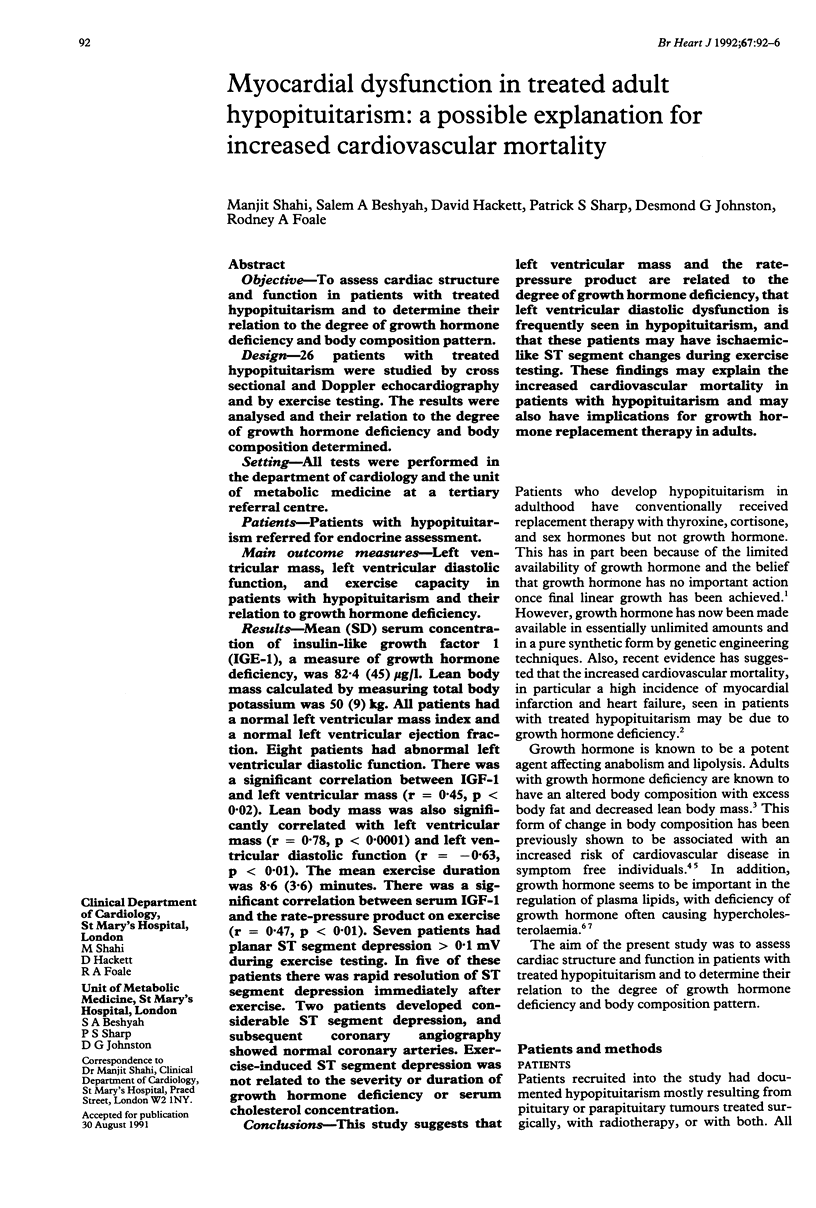
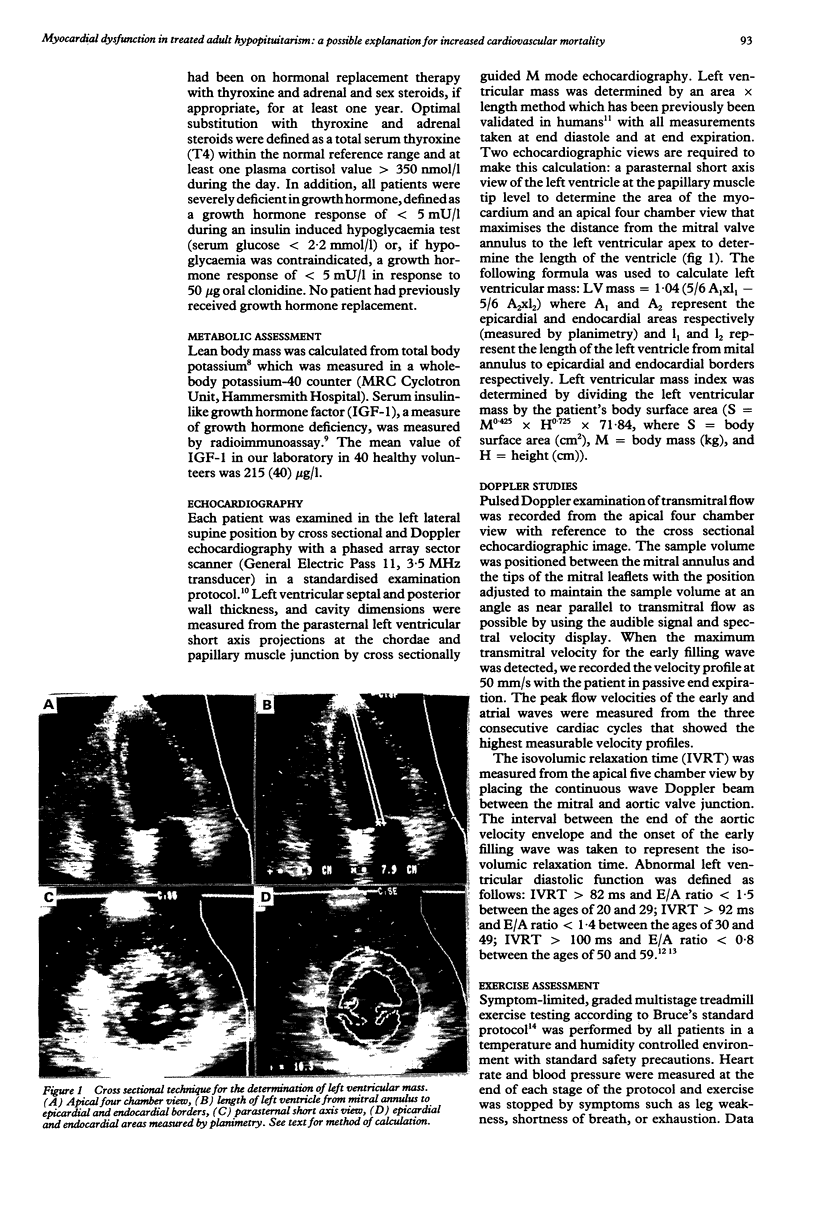
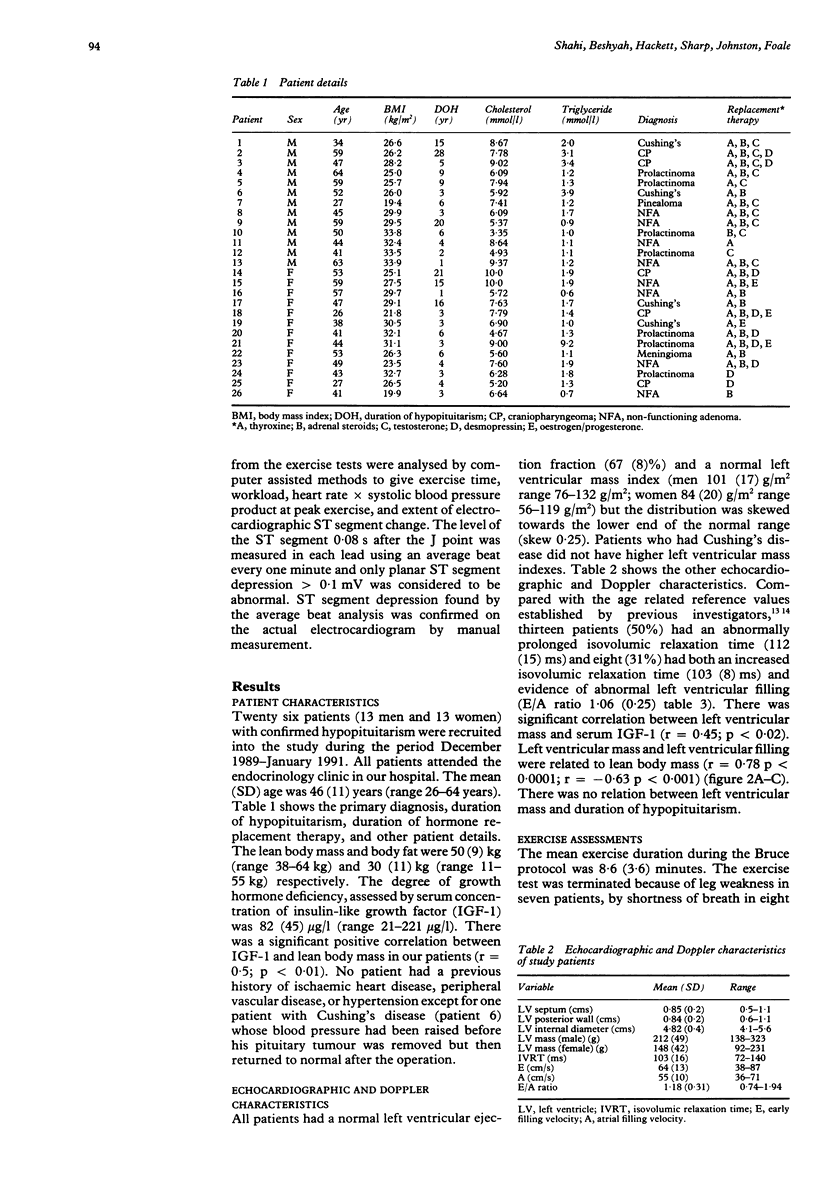
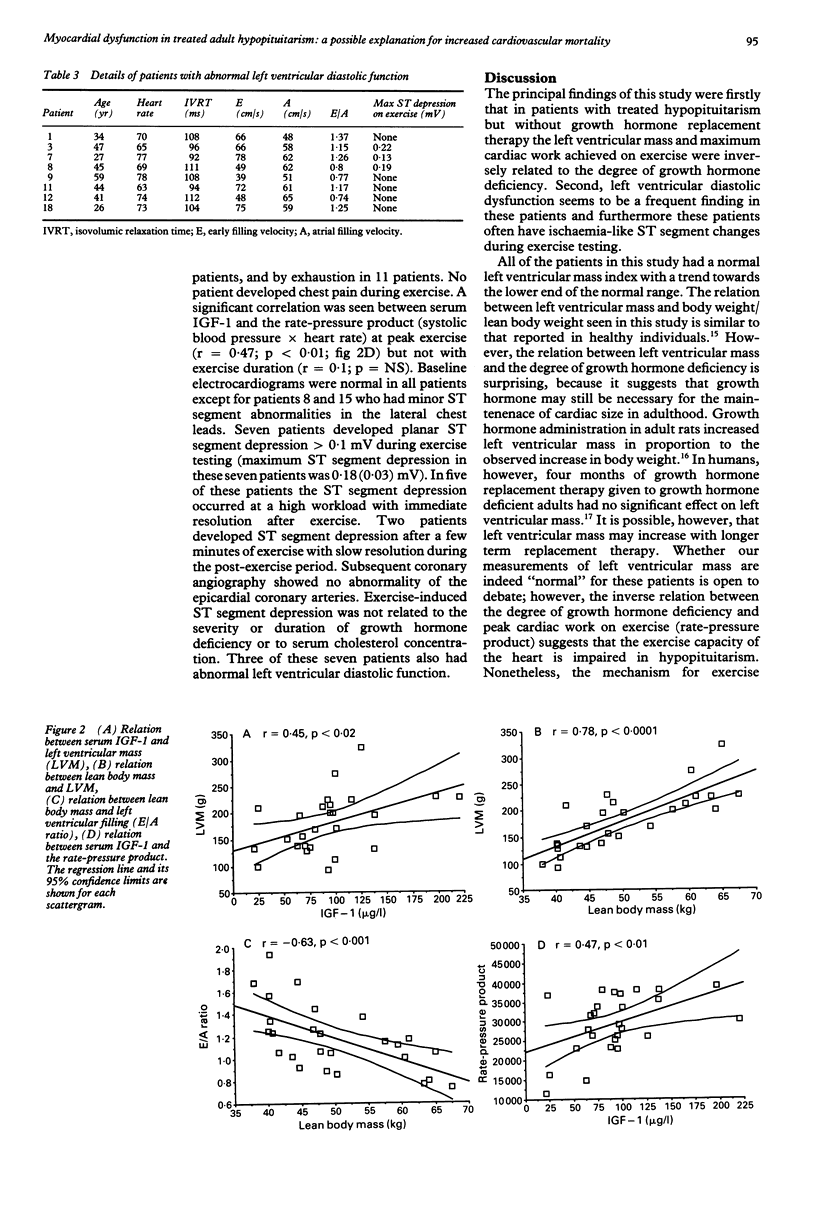
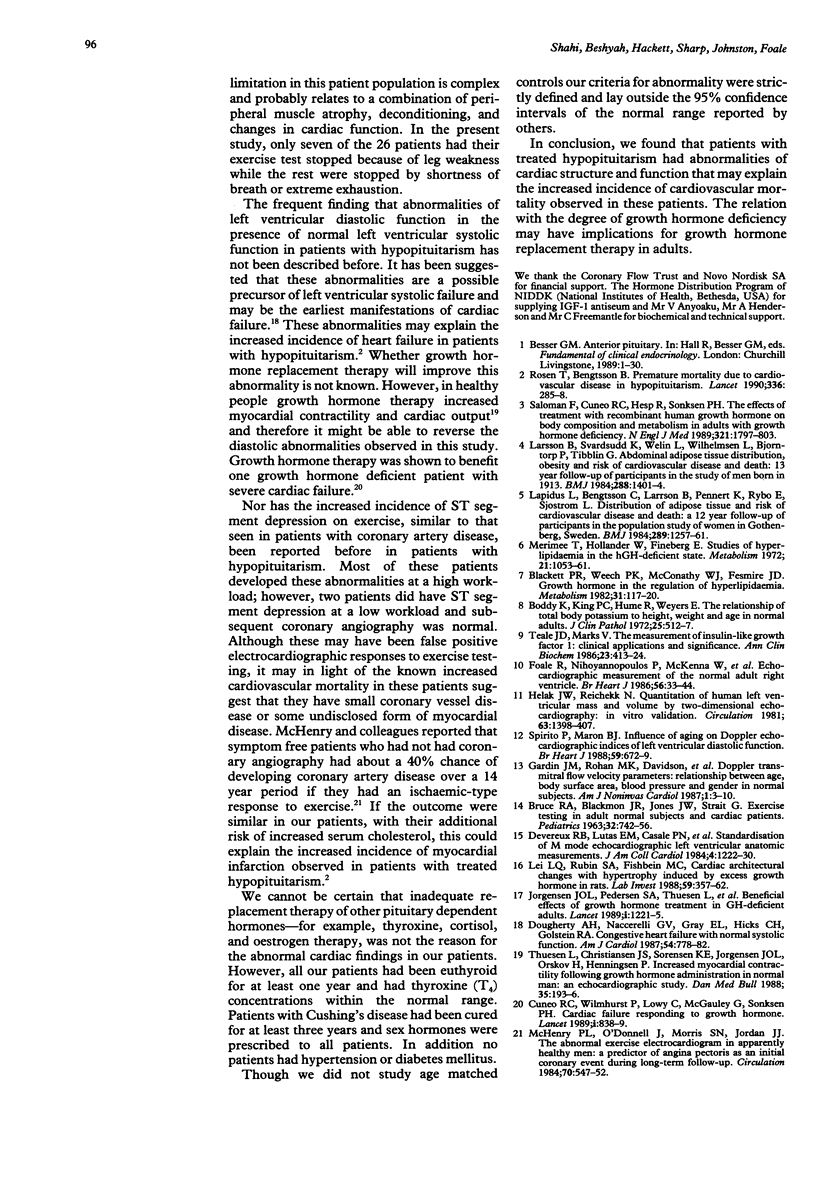
Images in this article
Selected References
These references are in PubMed. This may not be the complete list of references from this article.
- BRUCE R. A., BLACKMON J. R., JONES J. W., STRAIT G. EXERCISING TESTING IN ADULT NORMAL SUBJECTS AND CARDIAC PATIENTS. Pediatrics. 1963 Oct;32:SUPPL–756. [PubMed] [Google Scholar]
- Blackett P. R., Weech P. K., McConathy W. J., Fesmire J. D. Growth hormone in the regulation of hyperlipidemia. Metabolism. 1982 Feb;31(2):117–120. doi: 10.1016/0026-0495(82)90121-4. [DOI] [PubMed] [Google Scholar]
- Boddy K., King P. C., Hume R., Weyers E. The relation of total body potassium to height, weight, and age in normal adults. J Clin Pathol. 1972 Jun;25(6):512–517. doi: 10.1136/jcp.25.6.512. [DOI] [PMC free article] [PubMed] [Google Scholar]
- Cuneo R. C., Wilmshurst P., Lowy C., McGauley G., Sönksen P. H. Cardiac failure responding to growth hormone. Lancet. 1989 Apr 15;1(8642):838–839. doi: 10.1016/s0140-6736(89)92290-3. [DOI] [PubMed] [Google Scholar]
- Devereux R. B., Lutas E. M., Casale P. N., Kligfield P., Eisenberg R. R., Hammond I. W., Miller D. H., Reis G., Alderman M. H., Laragh J. H. Standardization of M-mode echocardiographic left ventricular anatomic measurements. J Am Coll Cardiol. 1984 Dec;4(6):1222–1230. doi: 10.1016/s0735-1097(84)80141-2. [DOI] [PubMed] [Google Scholar]
- Dougherty A. H., Naccarelli G. V., Gray E. L., Hicks C. H., Goldstein R. A. Congestive heart failure with normal systolic function. Am J Cardiol. 1984 Oct 1;54(7):778–782. doi: 10.1016/s0002-9149(84)80207-6. [DOI] [PubMed] [Google Scholar]
- Foale R., Nihoyannopoulos P., McKenna W., Kleinebenne A., Nadazdin A., Rowland E., Smith G., Klienebenne A. Echocardiographic measurement of the normal adult right ventricle. Br Heart J. 1986 Jul;56(1):33–44. doi: 10.1136/hrt.56.1.33. [DOI] [PMC free article] [PubMed] [Google Scholar]
- Helak J. W., Reichek N. Quantitation of human left ventricular mass and volume by two-dimensional echocardiography: in vitro anatomic validation. Circulation. 1981 Jun;63(6):1398–1407. doi: 10.1161/01.cir.63.6.1398. [DOI] [PubMed] [Google Scholar]
- Jørgensen J. O., Pedersen S. A., Thuesen L., Jørgensen J., Ingemann-Hansen T., Skakkebaek N. E., Christiansen J. S. Beneficial effects of growth hormone treatment in GH-deficient adults. Lancet. 1989 Jun 3;1(8649):1221–1225. doi: 10.1016/s0140-6736(89)92328-3. [DOI] [PubMed] [Google Scholar]
- Lapidus L., Bengtsson C., Larsson B., Pennert K., Rybo E., Sjöström L. Distribution of adipose tissue and risk of cardiovascular disease and death: a 12 year follow up of participants in the population study of women in Gothenburg, Sweden. Br Med J (Clin Res Ed) 1984 Nov 10;289(6454):1257–1261. doi: 10.1136/bmj.289.6454.1257. [DOI] [PMC free article] [PubMed] [Google Scholar]
- Larsson B., Svärdsudd K., Welin L., Wilhelmsen L., Björntorp P., Tibblin G. Abdominal adipose tissue distribution, obesity, and risk of cardiovascular disease and death: 13 year follow up of participants in the study of men born in 1913. Br Med J (Clin Res Ed) 1984 May 12;288(6428):1401–1404. doi: 10.1136/bmj.288.6428.1401. [DOI] [PMC free article] [PubMed] [Google Scholar]
- Lei L. Q., Rubin S. A., Fishbein M. C. Cardiac architectural changes with hypertrophy induced by excess growth hormone in rats. Lab Invest. 1988 Sep;59(3):357–362. [PubMed] [Google Scholar]
- McHenry P. L., O'Donnell J., Morris S. N., Jordan J. J. The abnormal exercise electrocardiogram in apparently healthy men: a predictor of angina pectoris as an initial coronary event during long-term follow-up. Circulation. 1984 Oct;70(4):547–551. doi: 10.1161/01.cir.70.4.547. [DOI] [PubMed] [Google Scholar]
- Merimee T. J., Hollander W., Fineberg S. E. Studies of hyperlipidemia in the HGH-deficient state. Metabolism. 1972 Nov;21(11):1053–1061. doi: 10.1016/0026-0495(72)90036-4. [DOI] [PubMed] [Google Scholar]
- Rosén T., Bengtsson B. A. Premature mortality due to cardiovascular disease in hypopituitarism. Lancet. 1990 Aug 4;336(8710):285–288. doi: 10.1016/0140-6736(90)91812-o. [DOI] [PubMed] [Google Scholar]
- Salomon F., Cuneo R. C., Hesp R., Sönksen P. H. The effects of treatment with recombinant human growth hormone on body composition and metabolism in adults with growth hormone deficiency. N Engl J Med. 1989 Dec 28;321(26):1797–1803. doi: 10.1056/NEJM198912283212605. [DOI] [PubMed] [Google Scholar]
- Spirito P., Maron B. J. Influence of aging on Doppler echocardiographic indices of left ventricular diastolic function. Br Heart J. 1988 Jun;59(6):672–679. doi: 10.1136/hrt.59.6.672. [DOI] [PMC free article] [PubMed] [Google Scholar]
- Teale J. D., Marks V. The measurement of insulin-like growth factor I: clinical applications and significance. Ann Clin Biochem. 1986 Jul;23(Pt 4):413–424. doi: 10.1177/000456328602300406. [DOI] [PubMed] [Google Scholar]
- Thuesen L., Christiansen J. S., Sørensen K. E., Jørgensen J. O., Orskov H., Henningsen P. Increased myocardial contractility following growth hormone administration in normal man. An echocardiographic study. Dan Med Bull. 1988 Apr;35(2):193–196. [PubMed] [Google Scholar]



